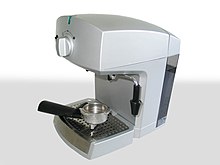Acrylonitrile-styrene-acrylate copolymer

Acrylonitrile-styrene-acrylate copolymers ( abbreviation ASA , also called acrylonitrile-styrene-acrylic ester copolymer ) are impact-resistant terpolymers made from the monomers acrylonitrile , styrene and an acrylic acid ester . ASA has similar properties to acrylonitrile-butadiene-styrene copolymer , but is much more weather-resistant.
Chemical structure
In the ASA, acrylic ester components are evenly distributed in a SAN ( styrene-acrylonitrile ) polymer and connected by grafted SAN chains. The acrylic ester component is dispersed, i. A. slightly cross-linked and acts as an impact modifier . N-Butyl acrylate is predominantly used for the synthesis ; certain proportions of cyclohexyl acrylate can be used as comonomer to improve the toughness at low temperatures .
During assembly , additives suitable for the respective application are incorporated into the plastic matrix. UV stabilizers , antioxidants and lubricants in particular should be mentioned here.
processing
Like all styrene polymers, ASA is mainly processed by injection molding, but also by extrusion (films). Heated element and rotary friction welding are possible, but less so are ultrasonic and high-frequency welding. In the 3-D printing process Fused Deposition Modeling , the ASA filament is used to manufacture 3D printed components, which above all have to absorb a certain amount of shock and impact energy without breaking.
properties
ASA forms high-quality, glossy and scratch-resistant surfaces. It can also be set transparent . Matt surfaces can be achieved by adding matting agents or generating larger acrylic ester phases.
The very good chemical resistance can be explained by the higher polarity of the acrylic ester component compared to the polybutadiene component in ABS. ASA shows a very good resistance to aqueous media including dilute acids / alkalis as well as detergents and good resistance to oils / fats, alcohols and aliphatic hydrocarbons. ASA is not resistant to many esters , ethers and ketones , the presence of which can cause the surface to swell and / or stress cracks.
use
ASA can be used as a weather-resistant panel in construction (PermaSkin ™), for high-temperature electrical devices such as B. coffee machines and microwaves can be used in sports and leisure as a surfboard or in the exterior of automobiles . Due to its high UV and weather resistance, the ASA is particularly suitable as a filament for 3-D printing for the production of prototypes. Likewise, end products that are not mass-produced, such as special parts for the outdoor area (cladding, brackets, operating fronts) can be manufactured with ASA filaments through additive manufacturing .
Trade names
Acrylic ester-styrene-acrylonitrile is produced and sold internationally under various brand names:
- Luran S ( Styrolution , Germany)
- Centrex ( Monsanto Chem. Plast , United States)
- Rhodapas ( Rhodia SA , formerly Rhône-Poulenc SA, France)
- Badalac ASA (Bada AG, Bühl / Germany)
In addition to plastic blends with polycarbonates produced (PC):
- Luran SC (Styrolution, Germany)
- Badalac ASA / PC (Bada AG, Bühl / Germany)
- Bayblend A ( Bayer AG , Germany)
Norms
- DIN EN ISO 6402-1 Plastics - Acrylonitrile-styrene-acrylate (ASA), acrylonitrile (ethylene-propylene-diene) -styrene (AEPDS) and acrylonitrile (chlorinated polyethylene) -styrene (ACS) molding compounds - Part 1 : Designation system and basis for specifications (ISO 6402-1: 2002); German version EN ISO 6402-1: 2002
- DIN EN ISO 6402-2 Plastics - Acrylonitrile-styrene-acrylate (ASA), acrylonitrile (ethylene-propylene-diene) -styrene (AEPDS) - and acrylonitrile (chlorinated polyethylene) -styrene (ACS) molding compounds - Part 2 : Preparation of test specimens and determination of properties (ISO 6402-2: 2003); German version EN ISO 6402-2: 2003
supporting documents
- ↑ Andrej Kupetz: A material brought into shape. Kunststoffe 5/2010, pp. 90-94.
- ↑ Christian Bonten: Plastics Technology Introduction and Basics , Hanser Verlag, 2014
- ↑ ASA plastic filament for 3D printing - EVO-tech 3D printer. In: EVO-tech 3D printer. Accessed June 3, 2019 (German).
- ↑ a b Hans Domininghaus: The plastics and their properties . Springer, Berlin-Heidelberg 2005 (6th edition); P. 776.
- ↑ Hans Domininghaus: The plastics and their properties . Springer, Berlin-Heidelberg 2005 (6th edition); P. 781.
literature
- Hans Domininghaus: The plastics and their properties. 6th revised and expanded edition. Springer, Berlin a. a. 2005, pp. 764-781, ISBN 3-540-21410-0 ( VDI book ).
